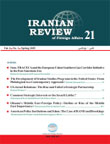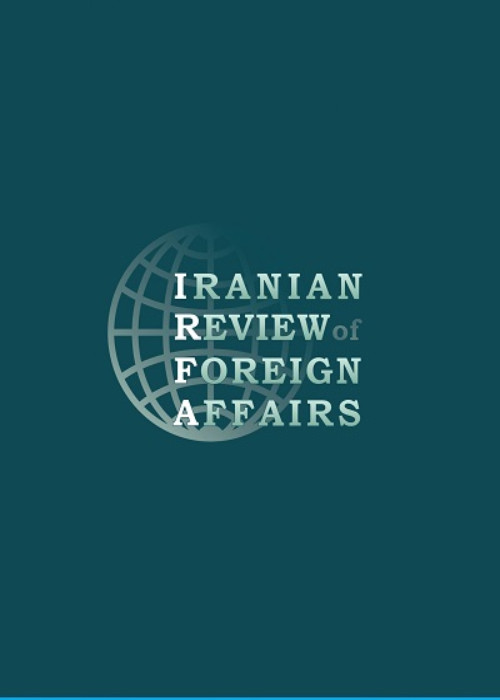فهرست مطالب

Iranian Review of Foreign Affairs
Volume:6 Issue: 1, Spring 2015
- تاریخ انتشار: 1394/02/30
- تعداد عناوین: 6
-
-
Page 5The geopolitical location of the Islamic Republic of Iran has made it a potential passage for transit of oil, natural gas, commercial products and passengers. This potential, however, has not been fulfilled due to U.S. policy of marginalizing Iran. With the resolution of the Iranian nuclear dispute, as a turning point in Irans relations with the outer world, the question is what are the implications of reduction of security considerations in Iran-EU relations and strengthening the Iranian development-oriented foreign policy for the two challenging initiatives of the Southern Gas Corridor and TRACECA? In response we argue that: in medium term, the most important impediment to Irans participation in the Southern Gas Corridor that is political will be removed but Iranian engagement in EUs TRACECA corridor will remain unchanged because of major infrastructural shortcomings. Iran can have an active participation in the Southern Gas Corridor.Keywords: European Union, Iran, the post–sanctions era, interstate initiatives, TRACECA
-
Page 31In the early twentieth century Iranian Studies began part of the classical academic model of Orientalism in the United States with a philological approach. Prominent universities and institutions in the US such as Harvard, Columbia, Stanford, Yale and UC Berkeley established departments of Iranian or Persian Studies. In the early programs more emphasis was given to the ancient Iranian civilization and language. A new approach emerged after the WWII and as a part of Middle Eastern Studies programs that attempted to study Iran from more modern and international academic perspective. Though Iranian studies became an independent field of study, it was the 1979 Iranian Islamic Revolution that changed Iranian Studies programs in the US drastically and gave it a political significance. The present paper offers a brief descriptive overview of the developments and evolutions of Iranian Studies programs in the United States and its different approaches in knowledge production toward Iran since its early years of establishment till the present time.Keywords: Iran, Iranian studies, United States, academia, the Iranian Revolution
-
Page 53The article uses neoclassical realism to analyze the evolution of US-Israeli relations from its modest beginnings in the 1940s and 50s, to its special status today. It is argued that the United States only began to seriously support Israel after Washington decision makers started to perceive the Jewish State as an important proxy in fighting Soviet influence in the Middle East, particularly following the Six Day War of 1967. However with the end of the Cold War Israels worth in pursing American interests in the region quickly faded, a change that was, brought into sharp perspective when in the First Persian Gulf War, Israel became a liability for the Americans. The article further argues that in the long run the strategic interests of the US in the region and subsequently the net strategic value of Israel for achieving such interests will be the primary driving factor behind US foreign policy. As a result factors such as the personal convictions of American politicians, the Jewish-American vote and the Israeli lobby would only be able to delay and dampen the future deterioration of the special relationship between Washington and Tel-Aviv.Keywords: US, Israel relations, US foreign policy, Israeli foreign policy, the Israel Lobby, Cold War rivalry
-
Page 79The role of Jewish lobbies in US decision-making processes is one of the disputable issues in international relations, which has drawn attention of the politicians, researchers and students. The present paper examines the functions of Jewish lobbies in US decisions-making structure as well as effective factors involved in it. Based on heuristic statistics presented in the current paper, and relying on empirical facts and employing quasi laboratory method, it will be argued that reducing the influence of Jewish lobby to the executive structure of US and exclusive alliance between Washington-Tel Aviv is an incomplete reality. Rather, Common Strategic Interests could help to better understand this relationship which puts the US national interests as pivotal element. Therefore, the main significance of Jewish lobby can be more assessed in domestic policy of America.Keywords: Jewish Lobby, national interests, rationality, common strategic interests
-
Page 101When Obama became the U.S. president, new policy toward war in Afghanistan and Iraq, that costs the U.S. dearly, was declared to respond to Americans needs and interests. The Pivot or Rebalance of power moved toward a larger region instead of the Middle East, e.g. the vast potential of the Asia Pacific region. In this light, the papers main question is What is the importance of the Middle East in Obamas foreign policy? And the response is Obamas policy toward Middle East is in decline for the rise of East Asia importance. During Obama administration, the decline of the U.S. power and the precieved threat of china and muslim radicalism forced him to deal with Iran as a regional power in the Middle East, and China as a regional power in the East Asia. Therefore, in a coherent strategy, Obama insisted to keep negotiations with Iran as the greatest strategic challenge in the Middle East. Accordingly, nuclear talks with Iran and also talks with Persian Gulf countries through Camp David in 2015, can be regarded as the U.S. willingness in GCC Iran engagement. Simultaneously and more importantly, pivot to Asia is a full spectrum force i.e., utilizing a smaller and more agile and advanced military force posture along side with economic strength to fulfill U.S. economic need i.e., jobs, export and investment in order to sustain U.S. global leadership in manage the rising China. Pivot to Asia is a formula for the 21th century that will empower U.S. in 22th century.Keywords: Obama, national interest, leadership, pivot to Asia, the Middle East, the East Asia
-
Page 129The present article is a constructivist framing analysis of the RAND and Brookings production of expertise on U.S. policy toward Islam. While the duality of moderation vs. radicalism is present in the narrative of both think tanks, their divergent construction of the meaning of these concepts results in the creation of two distinct frames. For RAND, the U.S. government needs to take side in the war of ideas within Islam, actively engaging in religion-building by promoting the creation of localized moderate, modernist forms of Islam and building networks of moderate Muslims. A Cold-War-driven modernization mentality is at the heart of such understanding of U.S. relations with Islam and the Islamic world. For Brookings, though, a more pragmatic construction of Muslim politics renders the Islamist dilemma obsolete and necessitates U.S. government engagement with moderate Islamists. Brookings advises the U.S. government to forego efforts at converting Islamists into post-Islamists or liberal Islamists and rather opt for efforts to engage those Islamists who are found to be committed to the democratic process and to reject a resort to violence. Despite their differences, what binds the framing of RAND and Brookings together is their rejection of the political Islam that threatens the hegemony of the United States and Israel in the region, i.e. that of the Islamic Republic of Iran and its affiliate resistance Islamic groups.Keywords: American policy, Islam, RAND, Brookings, Muslim


